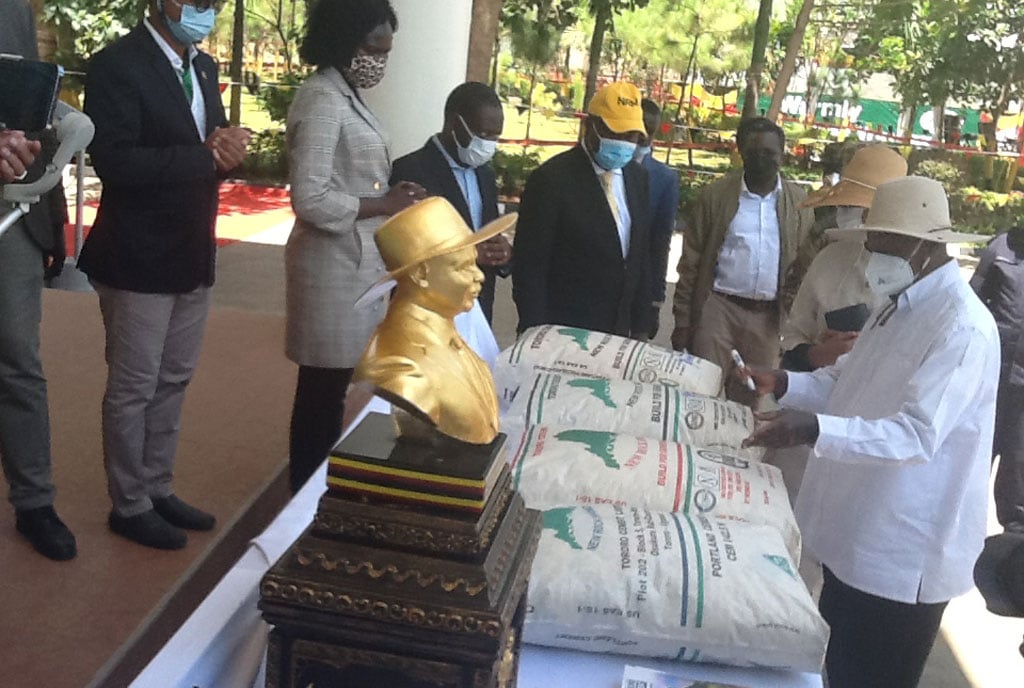Govt moves to curb cement smuggling

President Museveni signs on one of the cement bags during the commissioning of new Tororo Cement Vertical Milling Plant in Tororo District in September 2023. PHOTO/FILE
What you need to know:
- This comes after manufacturers and traders faulted the rampant cement smuggling to weak enforcement systems, saying the smugglers use even the gazetted borders where they pay some money to the enforcement officers and cross easily.
The government through Uganda Revenue Authority (URA) has enhanced surveillance and intelligence-led operations on the eastern border points to fight smuggling of cement from Kenya into Uganda.
This comes after Monitor investigations revealed that cheap illegal cement is being smuggled into the country through the porous border points, especially on Lwakhakha, Busia and Malaba borders.
This illicit trade involves both large and small scale traders, who use smaller vehicles to carry cement through uncontrolled border points.
The URA spokesperson, Mr Ibrahim Bbosa, said the Authority is taking action to prevent the smuggling of cement from neighbouring Kenya.
“While there is legal trade with significant amounts of Kenyan cement entering Uganda through official customs points, there has been a worrying increase in the smuggling of brands such as Simba and Bamburi,” he said in an interview at the weekend.
He said over the last two months, URA enforcement teams intercepted 3,286 bags of smuggled cement (164.3 metric tonnes).
“We also recruited credible informants to provide timely information on smuggling activities,” he said.
Mr Bbosa added that unscrupulous traders smuggle cement from Kenya using unmonitored routes, primarily using bicycles and motorcycles.
“These smuggled items are consolidated and then transported by trucks to various destinations within Uganda,” he said, adding that price difference between Ugandan and Kenyan cement is identified as the main driver of this illicit trade.
In Kenya, cement prices are approximately Ksh800 per bag (approximately Shs19,200), which is significantly lower than in Uganda.
Even with Shs4,200 tax per bag for traders with a certificate of origin, Kenyan cement is still more affordable.
He further said they have enhanced information sharing and coordination with government agencies at border points, including security and immigration departments.
“We will prosecute repeat offenders and individuals involved in smuggling activities,” he said, adding that they are committed to protecting the local cement industry from unfair competition brought about by smuggling activities.
He, however, said the customs officials have reported high clearances of cement from Kenya at several border points, including Lwakhakha Customs, which processed 224,604 bags of cement generating Shs950 million in taxes this year.
Similarly, the Suam River Customs Border accounted for 1,777 metric tonnes, yielding Shs148 million in tax revenue and Malaba Border’s contributions stood at 646.7 metric tonnes, with taxes amounting to Shs45 million.
URA enforcement officers said the government is also losing revenue since URA is supposed to collect Shs2,000 per 50kg bag of cement that gets into the country.
The Uganda-Kenya border stretches more than 800 kilometres, presenting a vast expanse that is difficult to monitor effectively.
Smugglers exploit this vastness, taking advantage of porous border areas, informal crossing points, and remote regions to carry out their activities.
Mr Amos Mafabi, a businessman operating at Lwakhakha Town Council in Namisindwa District, said the number of bags smuggled during each trip depends on the size of the vehicle or other means used in transportation.
“A bicycle boda boda can carry three 50kg bags, motorcycle boda boda can carry five and vans can drag as many as it can,” he said.
Mr James Opolot, who runs a hardware retail shop in Malaba, said if no intervention is sought, they will be forced out of business.
“Currently the cement from Kenya is being ferried directly to the construction sites leaving us without customers especially in the porous points in Buteba Sub County in Busia District,” he said.
He added: “We have been left with those customers who know the risks associated with smuggling otherwise we would be out of business already. Initially on good days, I would make sales of at worst 200 bags, but currently I hardly sell even 10 bags in a day.”
The traders and manufacturers fault the rise in the vice to weak enforcement systems, saying the smugglers use even the gazetted borders where they pay some money to the enforcement officers at the border.
The chief executive officer of Tororo Cement, Mr Morgan Gagran, said smuggling is bad for the economy.
“It should be stopped because it affects our market badly as manufacturers,” Mr Gagran.
He said some smugglers steal Tororo cement packaging bags in which they repackage their smuggled cement.
“We currently have enough quality cement on the Uganda market unlike the smuggled one which may be of poor quality,” he said.
Started in 1995, Tororo Cement reportedly holds 60 percent of Uganda’s cement market and produces about 5 million tonnes of cement annually.
Mr Robert Awori, a business consultant based in Tororo, said the government should work on standardising prices of products.
“There is no need for putting prices of cement high when the electricity used by the factories is produced within the country yet a country like Kenya that imports electricity from Uganda is selling cement cheaply,” he said.
Mr Awori said some of the hardware dealers have gone ahead to sell smuggled cement in their shops and only use Ugandan cement for display.
Condemnation
Mr Nickson Owole, the Tororo Resident District Commissioner, said as district security committee, which he heads, they have on numerous occasions discussed and put up stringent measures to curb the vice.
‘‘The vice is on the rise but because of the porous border points, we cannot deploy everywhere apart from the gazetted borders. However, we condemn it and ask our officers to scale up operations,’’ he said.




